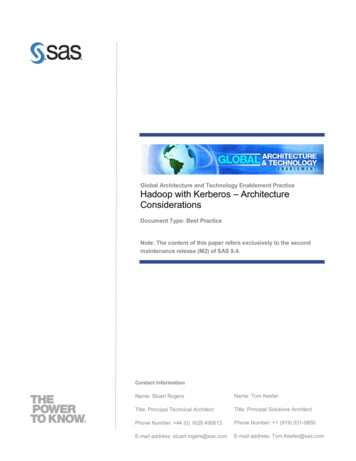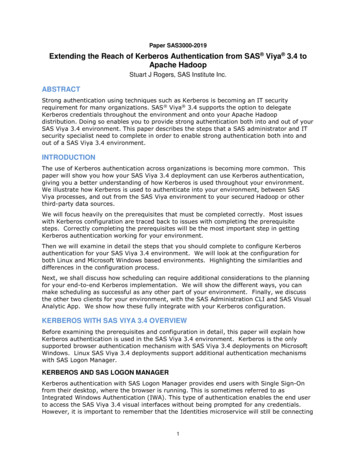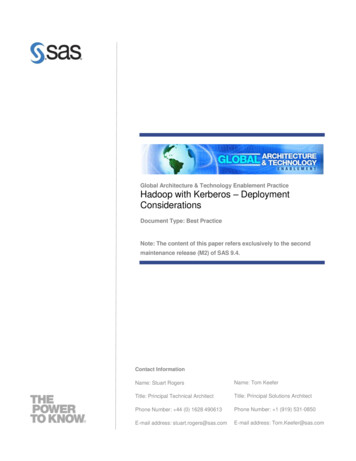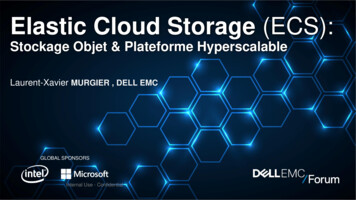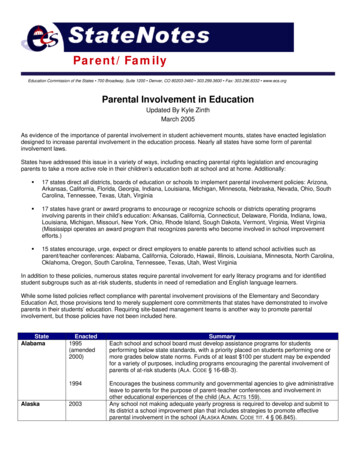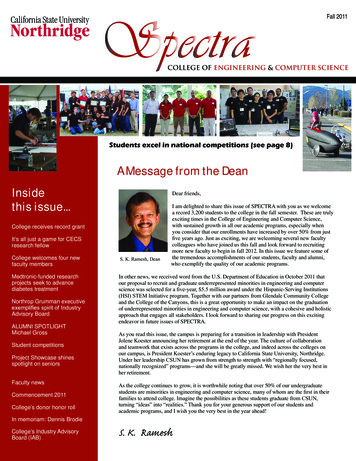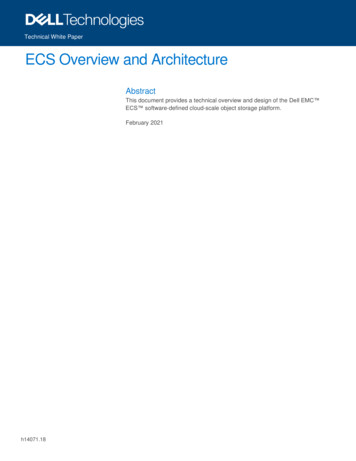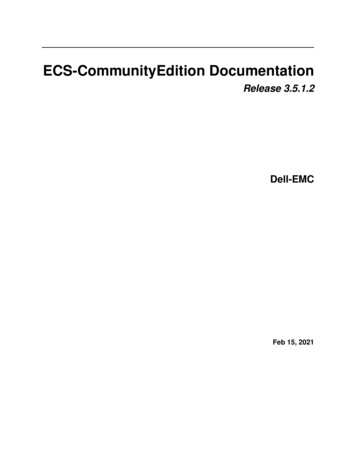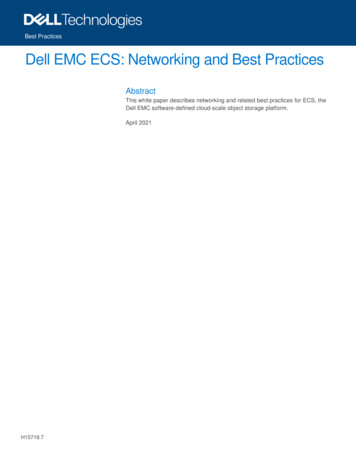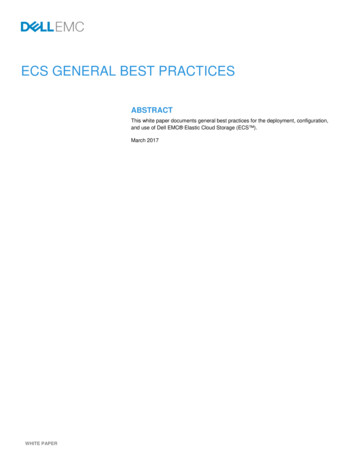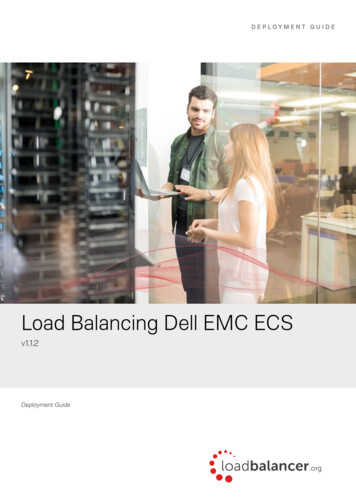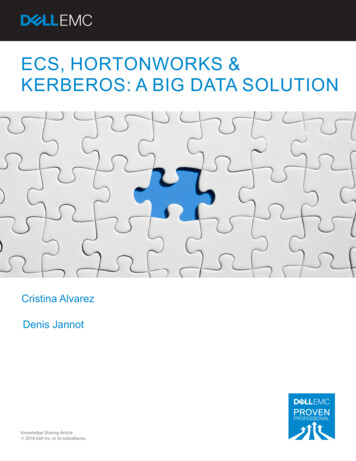
Transcription
ECS, HORTONWORKS &KERBEROS: A BIG DATA SOLUTIONCristina AlvarezDenis JannotKnowledge Sharing Article 2018 Dell Inc. or its subsidiaries.
Table of Contents1.Introduction . 42. Context & Background information . 52.1.Software pre-requisites. 52.2.Test environment - Naming Convention . 53. Kerberos Configuration . 63.1.Kerberos configuration in Active Directory . 63.1.1.System Security Services Daemon (SSSD) Configuration [Optional] . 93.2.Kerberos configuration in HortonWorks .103.3.Kerberos configuration in ECS .143.3.1.Keytab configuration .143.3.2.Bucket metadata – Securing ECS bucket .174. Hortonworks (HWX) integration with ECS .204.1.Configuring ECS HDFS Client Library JAR file on HDP nodes: .204.2.Config parameters in Ambari .205. ECS as a secondary FS in HDP cluster .225.1.Bucket configuration .225.2.Bucket access verification .225.2.1.AD user hdpuser1 / bucket hdpuser1bucket1 .225.2.2.AD user hdpuser1 / Bucket hdpuser1bucket2 .225.2.3.Multi user Access to a bucket - AD user hdpuser1 & hdpuser2 / Buckethdpuser2bucket1 .235.2.4.Multi-cluster access .246. ECS as the default HWX FS .246.1.Bucket configuration .246.2.HWX Configuration .256.3.Bucket access verification .267.S3a Configuration .278. Functional testing .288.1.Distcp operations.288.1.1.ECS as the default FS .288.1.2.ECS as a secondary FS.288.2.Hive tests .298.2.1.ECS as the default FS .298.2.1.1. Internal tables .298.2.1.2. External tables .318.2.2.ECS as a secondary FS.318.2.2.1. Internal tables .328.2.2.2. External tables .338.3.Spark tests .338.3.1.ECS as the default FS .348.3.2.ECS as a secondary FS.348.4.HBase tests .348.4.1.ECS as the default FS .348.4.2.ECS as a secondary FS.359. Benchmarks.379.1.TestDFSIO .372018 Dell EMC Proven Professional Knowledge Sharing2
9.1.1.Preparation .379.1.2.Write .379.1.3.Read .379.2.Teragen/Terasort/Teravalidate .379.2.1.Preparation .389.2.2.Write .389.2.3.Sort .389.2.4.Read .389.3.Hive-testbench .399.3.1.Preparation .399.3.2.Run .409.3.3.Analyze .409.1.Spark-perf tests .409.1.1.Preparation .409.1.2.Run .419.1.3.Analyze .4110.Conclusion.4211.References .42Disclaimer: The views, processes or methodologies published in this article are those of the authors.They do not necessarily reflect Dell EMC’s views, processes or methodologies.2018 Dell EMC Proven Professional Knowledge Sharing3
1. IntroductionWe are moving toward the fourth industrial revolution, in which mobile communications, social mediaand sensors are blurring the boundaries between people, the internet and the physical world. Welive in the age of the data. In a broad range of application areas, data is being collected at anunprecedented scale. Decisions that previously were based on guesswork, or on painstakinglyhandcrafted models of reality, can now be made using data-driven mathematical models. While suchBig Data analysis is clearly a new trend effective management and analysis of large-scale dataposes an interesting but critical challenge.Many IT companies have invested in Big Data products. Dell EMC is one such company that has puta lot of effort on this growing area, proposing alternatives to drive this Big Data challenge from thestorage perspective.Apache Hadoop has emerged as the preferred tool for performing powerful data analysis. Adistributed computing ecosystem designed to process large amounts of data very efficiently, Hadoopincludes a file-system and job engine, and is supported by an array of client interfaces. TraditionalHadoop analytics involves a series of complex workflows and data movement. Legacy Hadoopimplementations consist on one or several ingestion clusters (usually NAS systems) and one orseveral compute clusters (Hadoop cluster). And, usually, customers have to select and copy thedata between these two clusters to analyze it and extract results. This results in multiple copies ofthe data, extra network and storage resource consumption, complex data protection, delays,complex management, and scalability issues. But, what if the customer could analyze the data inplace in a system that already takes care of data protection and that is easily scalable? DellEMCElastic Cloud Storage provides a solution for that, being Hadoop Distributed File System (HDFS)compatible and allowing in-place analytics, offering native replication mechanisms, geo data access,multiprotocol data access, high availability, and simplifying the Hadoop architecture making thesolution easily scalable.To offer an end-to end solution, Dell EMC went through the certification process of Elastic CloudStorage (ECS) on Hortonworks (HWX), one of the Hadoop distribution market leaders, validating theintegration of both platforms, thereby saving customers time to implement the solution, whileproviding them with an assurance of interoperability.Additionally, most of the Hadoop implementations need a security mechanism to protect dataaccess. Kerberos is one of the most commonly-used authentication protocols. It is designed toprovide strong authentication for client/server applications by using secret-key cryptography. But it isextremely difficult to configure for those who are not experts on this matter.In conclusion, the integration of Hortonworks-ECS-Kerberos offers the end-to-end Hadoop solutionthat customers are seeking. However, it is still an emerging solution in the Dell EMC portfolio. Thispaper will augment existing documentation about how to configure, integrate, and test these threecomponents.This paper describes how to perform the complex configuration and integration among Kerberos,Hortonworks and ECS, how to run functional tests (including Distcp, Hive, Spark and HBase andframeworks, using ECS as internal or external file system in the Hadoop cluster), and how to runbenchmarks that demonstrate that ECS is a good fit for Hadoop frameworks where latency is notcritical, like Hive or Spark.2018 Dell EMC Proven Professional Knowledge Sharing4
2. Context & Background informationThe base information provided in this section helps to understand the different componentsdescribed in this article and the naming convention used in it.2.1. Software pre-requisites Hadoop Distributed Platform (HDP) 2.4.2 / 2.4.3 / 2.2 & Kerberizedo Check Hortonworks references to find the HWX version associated with each Hadoopversion.o In this document, Hortonwors (HWX) or HDP are used equally, referring to theHadoop node / cluster.ECS version 3.x, with basic configuration (namespace, user and bucket)o Check the ECS references to configure the system properly for these tests.Active Directory (AD) and Kerberos Key Distribution Center (KDC)o These tests have been done using a KDC in AD instance.2.2. Test environment - Naming ConventionTo make examples more understable, this is the naming convention used in this article : ECS nodes:o ecsparis1.paris.lab [10.10.10.11]o ecsparis2.paris.lab [10.10.10.12]o ecsparis3.paris.lab [10.10.10.13]o ecsparis4.paris.lab [10.10.10.14] HDP nodes:o hdp2.paris.lab [10.10.10.122] AD - KDC:o paris.lab [10.10.10.99] Users:ooooo hdp2admin – Admin user for hdp OU in ADvipr-ecsX users - AD users to create ECS keytabs in ADhdpuser1@PARIS.LAB - ECS / Hadoop userhdpuser2@PARIS.LAB - ECS / Hadoop userhdfs-hdp2@PARIS.LAB - ECS user - hdfs Service principal in Hadoop clusterBuckets:o hdpuser1bucket1 bucket - Owned by hdpuser1@PARIS.LAB usero hdpuser1bucket2 bucket - Owned by hdpuser1@PARIS.LAB usero hdpuser2bucket1 bucket - Owned by hdpuser2@PARIS.LAB usero hdp22 bucket - Owned by hdfs-hdp2@PARIS.LAB user Used for ECS as default File System (FS) configuration in HDP2018 Dell EMC Proven Professional Knowledge Sharing5
3. Kerberos ConfigurationThis section describes how to secure the communication between ECS, Hortonworks and the ActiveDirectory using Kerberos.3.1. Kerberos configuration in Active Directory In ECS:Configure the Authentication Provider in ECS: From the AD2018 Dell EMC Proven Professional Knowledge Sharing6
Create a new Organizational Unit (OU):Create a new admin User for that OU:Delegate the control of that OU to that recently created user:2018 Dell EMC Proven Professional Knowledge Sharing7
Using an AD for Kerberos, and not an external KDC, it is necessary to manually create: vipr-ecsX users in the AD Keytabs for the ECS in the ADktpass -princ vipr/ecsparis1.paris.lab@PARIS.LAB rndPass -mapUser vipr-ecs1@PARIS.LAB mapOp set -crypto All -ptype KRB5 NT PRINCIPAL -out ecsparis1.paris.lab@PARIS.LAB.keytabktpass -princ vipr/ecsparis2.paris.lab@PARIS.LAB rndPass -mapUser vipr-ecs2@PARIS.LAB mapOp set -crypto All -ptype KRB5 NT PRINCIPAL -out ecsparis2.paris.lab@PARIS.LAB.keytabktpass -princ vipr/ecsparis3.paris.lab@PARIS.LAB rndPass -mapUser vipr-ecs3@PARIS.LAB mapOp set -crypto All -ptype KRB5 NT PRINCIPAL -out ecsparis3.paris.lab@PARIS.LAB.keytabktpass -princ vipr/ecsparis4.paris.lab@PARIS.LAB rndPass -mapUser vipr-ecs4@PARIS.LAB mapOp set -crypto All -ptype KRB5 NT PRINCIPAL -out ecsparis4.paris.lab@PARIS.LAB.keytabSave the Keytabs. They will have to be copied to the ECS node [section 3.3.1].2018 Dell EMC Proven Professional Knowledge Sharing8
3.1.1. System Security Services Daemon (SSSD) Configuration [Optional]This section describes how to configure SSSD for your AD users, if desired. SSSD will allow ADusers to directly ssh into the hdp cluster, without the need of using kinit commands. On your hdp node:# yum -y -q install epel-release# yum -y -q install sssd oddjob-mkhomedir authconfig sssd-krb5 sssd-ad sssd-tools# yum -y -q install adcli# ad user "hdp2admin"# ad domain "paris.lab"# ad dc "10.10.10.99"# ad root "dc paris,dc lab"# ad ou "ou hdp2, {ad root}"# ad realm {ad domain }Kinit as your AD administrator:# kinit administratorPassword for administrator@PARIS.LAB:# echo adcli join -v \ --domain-controller {ad dc} \ --domain-ou " {ad ou}" \ --loginccache "/tmp/krb5cc 0" \ --login-user " {ad user}" \ -v \ --show-details# adcli join -v --domain-controller {ad dc} --domain-ou " {ad ou}" --login-ccache "/tmp/krb5cc 0"--login-user " {ad user}" -v --show-details#vi /etc/sssd/sssd.conf[sssd]## master & data nodes only require nss. Edge nodes require pam.services nss, pam, ssh, autofs, pacconfig file version 2domains PARIS.LABoverride space [domain/PARIS.LAB]id provider adad server 10.10.10.99auth provider adchpass provider adaccess provider adenumerate Falsekrb5 realm PARIS.LABldap schema adldap id mapping Truecache credentials Trueldap access order expireldap account expire policy adldap force upper case realm true2018 Dell EMC Proven Professional Knowledge Sharing9
fallback homedir /home/%d/%udefault shell /bin/falseldap referrals false[nss]memcache timeout 3600override shell /bin/bash# chmod 0600 /etc/sssd/sssd.conf# systemctl restart sssd.service# systemctl status sssd.service# sudo authconfig --enablesssd --enablesssdauth --enablemkhomedir --enablelocauthorize --update# sudo chkconfig oddjobd on# sudo service oddjobd restart# sudo chkconfig sssd on# sudo service sssd restart# sysctl status sssd.service# ssh B@hdp2.paris.lab's password:Creating home directory for hdpuser1@PARIS.LAB.3.2. Kerberos configuration in HortonWorks From the ADExtract the certificate from the AD sever. From the Hdp Linux host:Import the AD certificate: Create pem' and paste the certificatecontents Trust CA cert: # sudo update-ca-trust enable# sudo update-ca-trust extract# sudo update-ca-trust checkTrust CA cert in Java:# mycert em sudo keytool -importcert noprompt -storepass changeit -file {mycert} -alias ad -keystore /etc/pki/java/cacerts From the Ambari Graphical User Interface (GUI):Click “Enable Kerberos” tab and follow the wizard according to the following options:2018 Dell EMC Proven Professional Knowledge Sharing10
2018 Dell EMC Proven Professional Knowledge Sharing11
2018 Dell EMC Proven Professional Knowledge Sharing12
[ ]2018 Dell EMC Proven Professional Knowledge Sharing13
3.3. Kerberos configuration in ECS3.3.1. Keytab configurationCopy the keytabs, the ECS HDFS package and the UnlimitedJCEPolicy to the first ECS node.Note that HDFS support tools are provided in a HDFS Client ZIP file, hdfsclient- ECS version version .zip, that you can download from the ECS support pages on support.emc.com. Theunlimited JCE policy archive can be downloaded from oracle.com. On the first ECS node:# cd /home/admin# unzip hdfsclient-3.0.0.0.85807.98632a9.zip# unzip UnlimitedJCEPolicyJDK7.zipEdit inventory.txt in the playbooks/samples directory to refer to the ECS data nodes and KDC server:# vi les/inventory.txt[data nodes]10.10.10.[11:14][kdc]10.10.10.99# cp -r UnlimitedJCEPolicy les/# mkdir les/keytabs# cp *keytab les/keytabs/Start the utility container on ECS Node 1 and make the Ansible playbooks available to the container.# sudo docker load -i xz# sudo docker imagesREPOSITORYTAGIMAGE IDCREATEDVIRTUAL SIZEemcvipr/object3.0.0.0-86239.1c9e5ec 6b24682a1ecb6 weeks ago1.561 GB2018 Dell EMC Proven Professional Knowledge Sharing14
fabric/syslog1.3.0.0-3024.09f2704 0d85e0e3836910 weeks ago396.8 MBcaspian/fabric
paper will augment existing documentation about how to configure, integrate, and test these three components. This paper describes how to perform the complex configuration and integration among Ker
